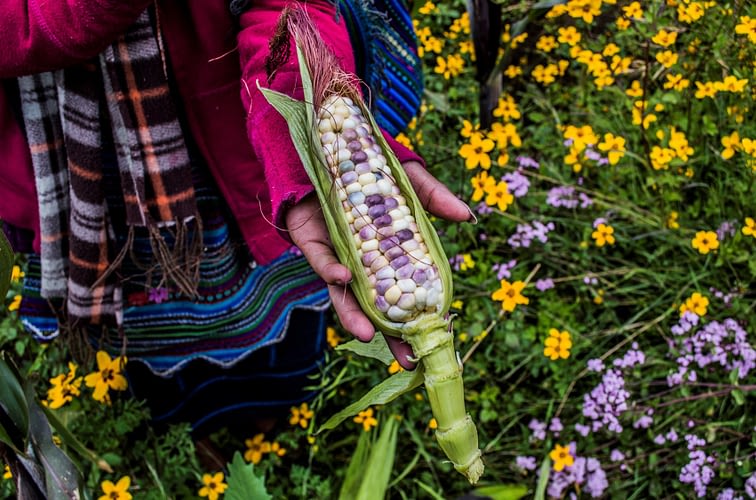
How milpa intercropping feeds communities

This article by Mike Listman was originally published on the website of the International Maize and Wheat Improvement Center (CIMMYT).
The traditional milpa intercrop — in which maize is grown together with beans, squash, or other vegetable crops — can furnish a vital supply of food and nutrients for marginalized, resource-poor communities in the Americas, according to a study published today in Nature Scientific Reports.
One hectare of a milpa comprising maize, common beans, and potatoes can provide the annual carbohydrate needs of more than 13 adults, enough protein for nearly 10 adults, and adequate supplies of many vitamins and minerals, according to the study. The research was based on data from nearly 1,000 households across 59 villages of the Western Highlands of Guatemala and is the first to relate milpa intercropping diversity with nutritional capacity, using multiple plots and crop combinations.
“The milpa was the backbone of pre-Columbian agriculture in North America, Mexico, and Central America,” said Santiago López-Ridaura, specialist in agricultural systems and climate change adaptation at the International Maize and Wheat Improvement Center (CIMMYT) and lead author of the article.
“Milpa production anchored around locally-adapted maize is still an essential food and nutritional lifeline for isolated, often indigenous communities throughout Mexico and Central America, and can be tailored to improve their food and nutritional security, along with that of small-scale farmers in similar settings,” he added.
Maize for feed or food and nutrition?
In modern times, some 1 billion tons of maize are harvested yearly from about 200 million hectares worldwide. Much of this output results from intensive monocropping of hybrids that yield an average 10 tons per hectare, in places like the U.S.
This massive world harvest goes chiefly for animal feed, corn starch, corn syrup, ethanol, and myriad industrial products, but in sub-Saharan Africa, Latin America, and parts of Asia, maize remains a critical food staple, often grown by smallholder farmers with yields averaging around 1.5 tons per hectare.
One hectare of a milpa comprising maize, common beans, and potatoes can provide the annual carbohydrate needs of more than 13 adults, enough protein for nearly 10 adults, and adequate supplies of many vitamins and minerals, according to the study.
The Western Highlands of Guatemala is among the world’s poorest regions — a mountainous area ill-served by markets and where communities battered by food insecurity and malnutrition sow crops at altitudes of up to 3,200 meters, according to Cristian A. Reyna-Ramírez, a co-author of the study from the Universidad Autónoma Metropolitana-Xochimilco, Mexico.
“Fully two-thirds of farmers in this region grow milpas based on maize but varying the intercrops with potatoes, faba bean, and even fruit trees,” Reyna-Ramírez said. “Our study showed that combinations such as maize-common bean-faba bean, maize-potatoes, and maize-common bean-potatoes provided the most carbohydrates, proteins, zinc, iron, calcium, potassium, folate, thiamin, riboflavin, vitamin B6, niacin and vitamin C.”
The traditional milpa intercrop — in which maize is grown together with beans, squash, or other vegetable crops — can furnish a vital supply of food and nutrients for marginalized, resource-poor communities in the Americas, according to a study published today in Nature Scientific Reports.
One hectare of a milpa comprising maize, common beans, and potatoes can provide the annual carbohydrate needs of more than 13 adults, enough protein for nearly 10 adults, and adequate supplies of many vitamins and minerals, according to the study. The research was based on data from nearly 1,000 households across 59 villages of the Western Highlands of Guatemala and is the first to relate milpa intercropping diversity with nutritional capacity, using multiple plots and crop combinations.
“The milpa was the backbone of pre-Columbian agriculture in North America, Mexico, and Central America,” said Santiago López-Ridaura, specialist in agricultural systems and climate change adaptation at the International Maize and Wheat Improvement Center (CIMMYT) and lead author of the article.
“Milpa production anchored around locally-adapted maize is still an essential food and nutritional lifeline for isolated, often indigenous communities throughout Mexico and Central America, and can be tailored to improve their food and nutritional security, along with that of small-scale farmers in similar settings,” he added.
Maize for feed or food and nutrition?
In modern times, some 1 billion tons of maize are harvested yearly from about 200 million hectares worldwide. Much of this output results from intensive monocropping of hybrids that yield an average 10 tons per hectare, in places like the U.S.
This massive world harvest goes chiefly for animal feed, corn starch, corn syrup, ethanol, and myriad industrial products, but in sub-Saharan Africa, Latin America, and parts of Asia, maize remains a critical food staple, often grown by smallholder farmers with yields averaging around 1.5 tons per hectare.
The Western Highlands of Guatemala is among the world’s poorest regions — a mountainous area ill-served by markets and where communities battered by food insecurity and malnutrition sow crops at altitudes of up to 3,200 meters, according to Cristian A. Reyna-Ramírez, a co-author of the study from the Universidad Autónoma Metropolitana-Xochimilco, Mexico.
“Fully two-thirds of farmers in this region grow milpas based on maize but varying the intercrops with potatoes, faba bean, and even fruit trees,” Reyna-Ramírez said. “Our study showed that combinations such as maize-common bean-faba bean, maize-potatoes, and maize-common bean-potatoes provided the most carbohydrates, proteins, zinc, iron, calcium, potassium, folate, thiamin, riboflavin, vitamin B6, niacin and vitamin C.”
The authors are grateful for funding from the United States Agency for International Development (USAID) as part of Feed the Future, the U.S. Government’s global hunger and food security initiative, under the Buena Milpa project, as well as the support of the CGIAR Research Program on Maize.
Read the full article:
Maize intercropping in the milpa system. Diversity, extent and importance for nutritional security in the Western Highlands of Guatemala
